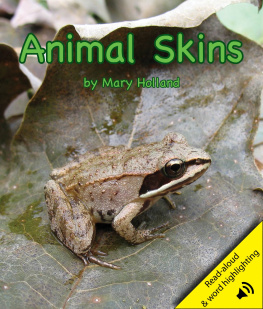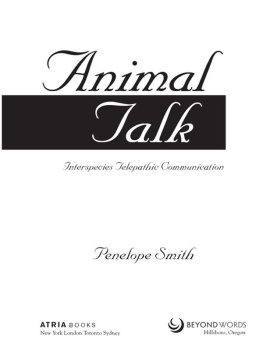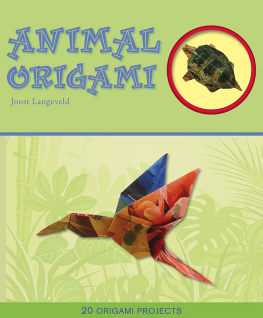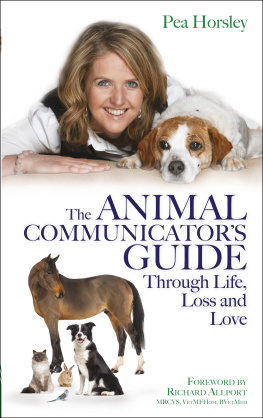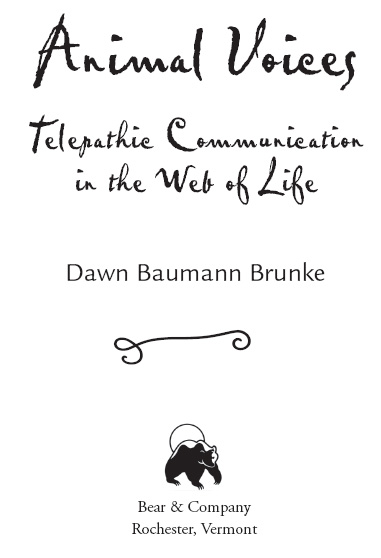
Praise for Animal Voices
Dawn Brunke takes us along on her incredible journey as she learns how to communicate with animals. She teaches us that animals are our teachersthey teach us to trust ourselves, and as a result of that trust we find out who we are. Whether you are a skeptic or a believer, Animal Voices will give you valuable new insight into the world of telepathic animal communication.
Carol Gurney,
animal communicator and author of The Language of Animals
Powerful! Moving! A compelling journey reminding us that the wisdom of the animal kingdom offers a window to our own inner mysteries. Through personal experience and intimate case histories, Dawn Brunke has masterfully crafted a must read for skeptics and animal lovers, alike.
Gregg Braden,
author of Awakening to Zero Point, Walking Between the Worlds, and The Isaiah Effect: Decoding Our Future through the Lost Science of Prophecy
Animal Voices cuts through the shadow of our projections and beliefs about animals with both warmth and wit. These loving and wise messages from our feathered, furred, and exoskeleton-clad kin will move hearts and minds in new directions, inspiring even the most skeptical reader. Provocative, healing, and a must read for anyone who has opened his or her heart to another species.
Joanne Lauck, author of The Voice of the Infinite in the Small: Re-visioning the Insect-Human Connection
This is an important and amazing book! With grace and eloquence, Dawn Brunke takes the reader on a wondrous journey into the rich potential of the human-animal connection. Packed with profound insights and joyful surprises, Animal Voices is educational, entertaining, and extremely pertinent to the urgent need on our planet for a deeper understanding of all life.
Steve Johnson,
flower essence therapist and author of The Essence of Healing

Giraffe in Africa. Photo by Dawn Brunke.
Acknowledgments

This is a book of many voices. My heartfelt appreciation goes to all who have contributed, whether their names appear within these pages or not.
Thanks to communicators and friends: Chrys Long-Ago, Carole Devereux, Jane Hallander, Sam Louie, Penelope Smith, Raphaela Pope, Mary Getten, Teresa Wagner, Marta Williams, Ilizabeth Fortune, Joan Ocean, Carol Gurney, Morgine Jurdan, Nedda Wittels, Nancie LaPier, Marcia Ramsland, Diana Roth, Toraya Ayres, Anita Curtis, Jeri Ryan, Sharon Callahan, Jim Worsley, Laura Simpson, and Jude White Bear.
Thanks to manuscript readers who offered valuable feedback, suggestions, and support through various revisions: Sam Louie, Nancie LaPier, Toraya Ayres, Jackie Rahm, Charlie Renideo, Delisa Renideo, Joanne Lauck, A.B., and my mother, Carol Edler Baumann.
Thanks for written words of inspiration and reassurance: J. Allen Boone and Strongheart, Penelope Smith, Brugh Joy, Walt Whitman, and Michael Roads.
Thanks to all the good people at Inner Traditions/Bear & Company, in particular to my editor Laura Schlivek, to Peri Champine for a great cover, and to Jon Graham in Acquisitions, who endured my persistence. Thanks to my copy editor, Victoria SantAmbrogio. Thanks also to Jackie Kosednar, publisher of Alaska Wellness, for faith and trust.
Thanks to my parents for lifelong support. And to family and friends for sharing the excitement. Thanks to my husband, Bob, for unwavering encouragement, and to my daughter, Alyeska, for irrepressible joy, laughter, and love of animals.
A deep and profound thanks to all of the animal beings and spirits who started this. This book never would have happened without youthe many individual animals and animal groups who so generously contributed insight, wisdom, eloquence, and humor. Thanks to the birds on the bush, the goldfish, moths, mosquitoes, and spiders, who presented challenging information just when I needed it most.
Finally, an extra special thanks to my very good pals, Barney, Max, and Zak, who sat with me daily during the writing of this book, who nudged me on to awakening with an encouraging soft paw, and who continue to remind me that life, and death, are grand adventures indeed.
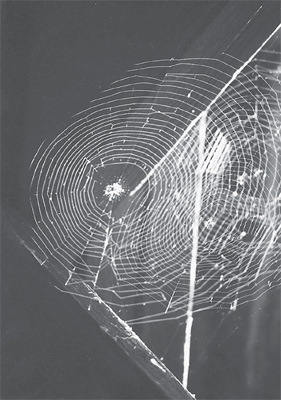
Spider web. Photo by Dawn Brunke.
Introduction
The Web
I dont understand it. But for that matter I dont understand how a spider learned to spin a web in the first place. When the words appeared, everyone said they were a miracle. But nobody pointed out that the web itself is a miracle.
E.B. White, Charlottes Web
As a child, one of my favorite books was Charlottes Web by E. B. White. I especially loved Charlotte, a quick-witted gray spider, who spun words into her web in an attempt to save her friend Wilbur the pig from an untimely death. Some pig! boldly exclaimed the words in Charlottes web. Radiant and Humble were other adjectives Charlotte used to describe Wilbur. Most of the farmers and townspeople believed the words were miracles, supernaturally inspired messages that could not be explained. They looked to the pig, certain that he was the one behind the mystery. Charlotte smiled, delighted that her trick had worked.
As Charlotte explained to Wilbur, spiders have been weaving webs for generation upon generation. I dont know how the first spider in the early days of the world happened to think up this fancy idea of spinning a web, but she did, and it was clever of her, too, said Charlotte. I thought it was equally clever of Charlotte to be a spider who understood how words could so greatly influence humans.
There are some who believe that spiders spin webs not merely from instinct, but with the collective memory of all spiders who have ever spun webs since that first spider in the early days. As each spider spins a web, the idea goes, it becomes easier for all spiders to create webs, spinning with less effort and the potential for greater intricacy.
Some believe that human evolution follows a similar path. As a new talent is discovered by one individual, others may simultaneously or soon thereafter find the talent within themselves. As more individuals engage in the new behavior, it becomes easier for others. Call it the hundredth monkey, the hundredth spider, or even the hundredth human; it is all a variation of the same pattern in the grand Web.
The Web of Life reminds us that every thought and action affects everyone and everything. An idea comes to one of us and a thread on the invisible web quivers as circumstances conspire to bring events, ideas, people, animals, and countless other forms of assistance into our lives.
Although this book began with a simple interest in animal communication, it has become a widespread collaboration. More than two dozen communicators and one hundred animals have shared their energy, wisdom, humor, and blessings for the completed work to unfold.
Just as the barnyard animals brought Charlotte word suggestions to display on her web, just as E. B. White collaborated with the subtle energy of a wonderful gray spider he called Charlotte, we are all, consciously or unconsciously, working together to create something quite spectacular, something that propels us into a new creation of Being.
Next page



